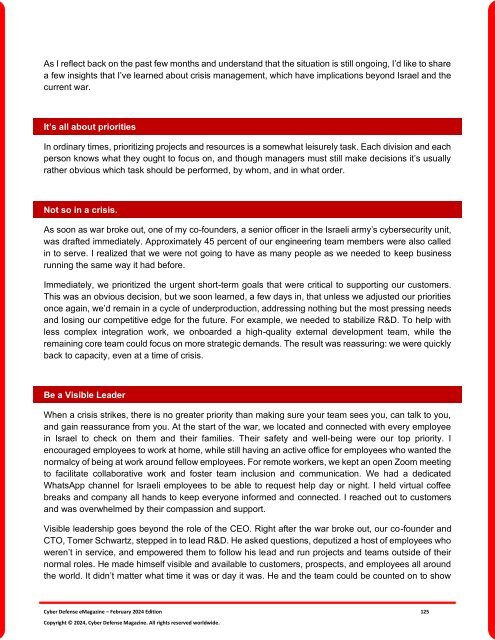The Cyber Defense eMagazine February Edition for 2024
Cyber Defense eMagazine February Edition for 2024 #CDM #CYBERDEFENSEMAG @CyberDefenseMag by @Miliefsky a world-renowned cyber security expert and the Publisher of Cyber Defense Magazine as part of the Cyber Defense Media Group as well as Yan Ross, Editor-in-Chief and many more writers, partners and supporters who make this an awesome publication! 155 page February Edition fully packed with some of our best content. Thank you all and to our readers! OSINT ROCKS! #CDM #CDMG #OSINT #CYBERSECURITY #INFOSEC #BEST #PRACTICES #TIPS #TECHNIQUES
Cyber Defense eMagazine February Edition for 2024 #CDM #CYBERDEFENSEMAG @CyberDefenseMag by @Miliefsky a world-renowned cyber security expert and the Publisher of Cyber Defense Magazine as part of the Cyber Defense Media Group as well as Yan Ross, Editor-in-Chief and many more writers, partners and supporters who make this an awesome publication! 155 page February Edition fully packed with some of our best content. Thank you all and to our readers! OSINT ROCKS! #CDM #CDMG #OSINT #CYBERSECURITY #INFOSEC #BEST #PRACTICES #TIPS #TECHNIQUES
Create successful ePaper yourself
Turn your PDF publications into a flip-book with our unique Google optimized e-Paper software.
As I reflect back on the past few months and understand that the situation is still ongoing, I’d like to share<br />
a few insights that I’ve learned about crisis management, which have implications beyond Israel and the<br />
current war.<br />
It’s all about priorities<br />
In ordinary times, prioritizing projects and resources is a somewhat leisurely task. Each division and each<br />
person knows what they ought to focus on, and though managers must still make decisions it’s usually<br />
rather obvious which task should be per<strong>for</strong>med, by whom, and in what order.<br />
Not so in a crisis.<br />
As soon as war broke out, one of my co-founders, a senior officer in the Israeli army’s cybersecurity unit,<br />
was drafted immediately. Approximately 45 percent of our engineering team members were also called<br />
in to serve. I realized that we were not going to have as many people as we needed to keep business<br />
running the same way it had be<strong>for</strong>e.<br />
Immediately, we prioritized the urgent short-term goals that were critical to supporting our customers.<br />
This was an obvious decision, but we soon learned, a few days in, that unless we adjusted our priorities<br />
once again, we’d remain in a cycle of underproduction, addressing nothing but the most pressing needs<br />
and losing our competitive edge <strong>for</strong> the future. For example, we needed to stabilize R&D. To help with<br />
less complex integration work, we onboarded a high-quality external development team, while the<br />
remaining core team could focus on more strategic demands. <strong>The</strong> result was reassuring: we were quickly<br />
back to capacity, even at a time of crisis.<br />
Be a Visible Leader<br />
When a crisis strikes, there is no greater priority than making sure your team sees you, can talk to you,<br />
and gain reassurance from you. At the start of the war, we located and connected with every employee<br />
in Israel to check on them and their families. <strong>The</strong>ir safety and well-being were our top priority. I<br />
encouraged employees to work at home, while still having an active office <strong>for</strong> employees who wanted the<br />
normalcy of being at work around fellow employees. For remote workers, we kept an open Zoom meeting<br />
to facilitate collaborative work and foster team inclusion and communication. We had a dedicated<br />
WhatsApp channel <strong>for</strong> Israeli employees to be able to request help day or night. I held virtual coffee<br />
breaks and company all hands to keep everyone in<strong>for</strong>med and connected. I reached out to customers<br />
and was overwhelmed by their compassion and support.<br />
Visible leadership goes beyond the role of the CEO. Right after the war broke out, our co-founder and<br />
CTO, Tomer Schwartz, stepped in to lead R&D. He asked questions, deputized a host of employees who<br />
weren’t in service, and empowered them to follow his lead and run projects and teams outside of their<br />
normal roles. He made himself visible and available to customers, prospects, and employees all around<br />
the world. It didn’t matter what time it was or day it was. He and the team could be counted on to show<br />
<strong>Cyber</strong> <strong>Defense</strong> <strong>eMagazine</strong> – <strong>February</strong> <strong>2024</strong> <strong>Edition</strong> 125<br />
Copyright © <strong>2024</strong>, <strong>Cyber</strong> <strong>Defense</strong> Magazine. All rights reserved worldwide.

















